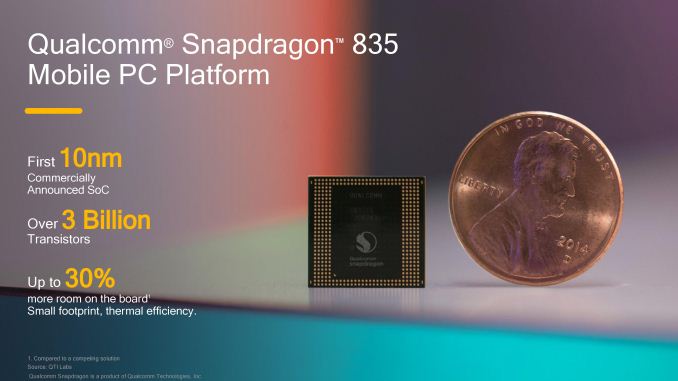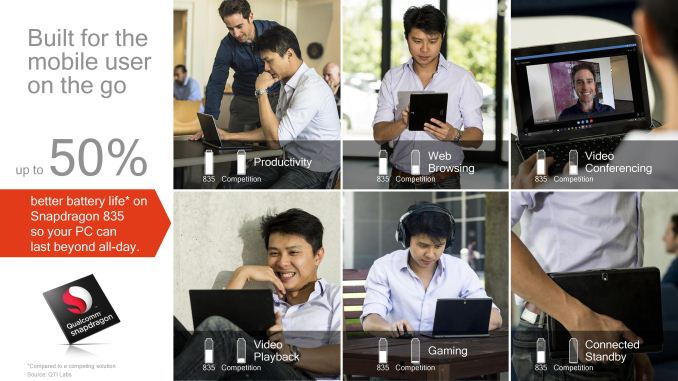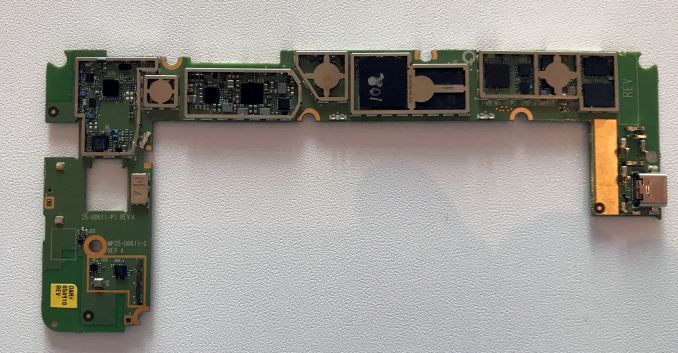Qualcomm Announces First OEMs for Windows 10 on Snapdragon 835
by Ian Cutress on May 31, 2017 3:30 AM EST
Today, as part of Computex 2017, Qualcomm and Microsoft are joint announcing the next steps for their Windows on Snapdragon strategy. As previously reported, Qualcomm and Microsoft have collaborated to emulate x86 on the Snapdragon 835 SoCs such that Windows 10/ARM can now run x86 Windows applications, and this emulation has reached a point where it's ready for devices to come to market.
ASUS, HP and Lenovo will be the first OEMs to adopt the platform, which means we will see devices (laptops, clamshells, 2-in-1s) with the desktop version of Windows 10 but running on ARM. Qualcomm notes that the ubiquitous connectivity akin to smartphones is becoming an important aspect to how users use their computers as well as consume content – introducing the Snapdragon 835 on a productivity platform combined with the integrated Gigabit LTE baseband (Qualcomm’s X16) is a step in that direction along with mobile SoC levels of power draw.
When we first heard about Windows on Snapdragon, we instantly thought that Qualcomm and Microsoft would be going after the Chromebook market, but the announcement today is clear that both companies are going for something a bit more substantial along with all-day battery life. The official press release states that ‘Sleek, thin and fanless PCs running a Windows 10 experience’, with the 10nm SoC, sounds something more than a basic Chromebook.
One might suggest that the Snapdragon 835 is a premium SoC, and Qualcomm certainly wants to promote their hardware in high-end premium devices. With Snapdragon 835 in high-end smartphones, one of the elements Qualcomm is promoting is the fact that their SoC solution has a smaller PCB footprint: OEMs can use the extra space and weight for extra battery. This is part of the story which Qualcomm states allowing a ‘truly always on’ device such that updates can run in the background when the system is in sleep modes.
As part of the demonstrations on the Computex show floor, Qualcomm was showing Windows 10 being used with UWP applications but also some non-UWP apps being used, such as 7-zip. The OS element is something we’re likely to hear during Microsoft’s announcements during the week, which I feel might be a tipping point for these sorts of platforms. I’ve been using the MateBook X this week during Computex, and the battery life is actually fairly decent for an 1800 Euro ultraportable with a 15W CPU: but there’s still a small amount of battery anxiety for sure, especially during network use. Qualcomm’s value-add is their baseband experience, which they say is a big plus on this new platform.
Having a proper productivity device is a plus, but big questions still surround performance, especially when emulating x86. It’s a problem that has been tackled several times before without much success. The Qualcomm issue here is somewhat smaller than previous attempts, because as far as we understand it only has to target Windows 10, and they’ve worked directly with Microsoft in order to support it. Qualcomm and Microsoft say that this combination is now a solved problem with minimal overhead.
The carousel image at the top shows the S835 compared to a 14nm equivalent, showing the 'board space' savings of up to 30%. Qualcomm is keen to point out that a competitor's platform will need things like M.2 in order to add storage, which they say also take up board space compared to a Qualcomm solution.
Footprints
As part of our briefing, Qualcomm showed off an example reference PCB design that might go into the devices that they are targeting.
On the left is an Intel solution, and on the right is Qualcomm's S835 solution: 96.1cm2 compared to 50.4cm2 respectively. Here's a closer image of the Qualcomm solution (click through for high resolution):
The SoC is on the top right, with storage and memory to the left. It's worth noting on the far right is a USB Type-C connection, which would be the power input as well as how to connect other devices. There is no SIM card, because Qualcomm has integrated a multi-region eSIM which is activated at the time of purchase.




















24 Comments
View All Comments
jjj - Wednesday, May 31, 2017 - link
Problem is that Qualcomm doesn't have a proper PC SoC or even a tablet SoC.They only care about pushing LTE and expanding licensing so they neglect all other markets.
Here you'll have limited PC perf at a price premium due to connectivity while folks that can afford the LTE connected machine, tend to buy better PCs.
On top of that, this is a high end phone SoC and high end is another price premium.
OEMs will have to build low perf shiny machines with high res displays and charge 500$ and up to get away with it. A 250$ machine that retails for 350$ just because it has LTE doesn't work.
It's also said that Microsoft and the OEMs are investing in this instead of asking for a viable solution.This kind of behavior is why the industry keeps making poor products, decade after decade.
SD835 perf at 25-30$ with no LTE would be great but not this , at 2x the price.
Hopefully M$ expands support to other SoCs and maybe we get decent machines further down the road.
R0H1T - Wednesday, May 31, 2017 - link
Hmm I don't know, with the recent US ban on laptops these might really take off. Then again we'll have to see how well the x86 emulation works & the number of "apps" that work on this competing platform. The latter will decide it if does end up being another WinRT or doubles up as a serious competitor to something like the MS' Surface.Zizy - Wednesday, May 31, 2017 - link
Eh, Surface 3 was doing OK-ish with atom until other OEMs made same-but-better devices. Now imagine it with this and all the new chip brings: higher performance even in x86 stuff, way better battery life, USB-C, LTE built in, thinner and lighter. Add this new SP pen, hinge and keyboard, and it is a pretty compelling note taking/drawing device.milli - Wednesday, May 31, 2017 - link
'higher performance even in x86 stuff'You know this for a fact? Source?
BedfordTim - Wednesday, May 31, 2017 - link
Geekbench gives us an indication that this should be faster than a Surface 3. Only time will tell but it is highly unlikely the OEMs are going to be selling premium devices that aren't any good.tuxRoller - Wednesday, May 31, 2017 - link
GB isn't apples to apples, but it's the best we have easy access to.So, keeping GB in mind, subtract from that score the emulation overhead compared to the well optimized Linux that provided the GB results in the first place.
phoenix_rizzen - Wednesday, May 31, 2017 - link
Will be interesting to see how portable the changes to Windows 10 are to make it run on this SoC. Are they generic enough that it'll run on any future SoC? Or are they SoC-specific? Meaning, the x86 translation stuff.If it's portable enough, it will be interesting to see what other OEMs come up with using DynamIQ-based SoCs with A75/A55 CPUs. :)
This could lead to a resurrection of the Windows NetBook.
Alexvrb - Wednesday, May 31, 2017 - link
A75 has a wider TDP range, too. Scales up better. Also, I hope they never use the term Netbook again. It invokes images of hideous, clunky, horribly slow pieces of garbage. Just call them Ultrathins or whatnot.mkozakewich - Friday, June 2, 2017 - link
I'd say the usage model for actual netbooks is dead. If people want a small computer, they want a tablet, and there are plenty of good tablets that dock to good keyboards. (I've actually got one coming in the mail.) This will definitely extend that market, as seen in the battery life image in this post. (The guy obviously has a tablet with a keyboard folio.)Alexvrb - Wednesday, May 31, 2017 - link
You're being irrational. Ask for a viable solution? Ask who? Intel? They've been working with Intel for years... yet Intel abandoned ULP Atoms - Cherry Trail-T was the last tablet/hybrid and low-cost slim notebook friendly chip. Everything else in their lineup is either higher cost (yes, higher than 835) or higher watt, and sometimes both. AMD isn't even close to having anything in this category - AMD has more profitable markets to target for the foreseeable future.MS and their partners had two choices: Completely abandon these segments of the market (low-cost lightweight laptops/hybrids/tablets) to another OS running ARM chips... or run ARM chips. Gasp, they chose to run ARM chips - and this time they came up with a solution on their own that allows them to maintain Win32 compatibility! Windows itself was already portable to other platforms (such as ARM). Now they've ported the entire Win32/DX/etc library stack (they had ported a subset previously with WinRT).
This also means that performance will be good even when running "emulated" Win32 programs. They're not emulating an entire x86 system. The OS and MS software and libraries are all native ARM. They're also using advanced emulation techniques. Now they can use modern ARM SoCs like 835 and beyond to offer OEMs and customers better-than-Atom performance at competitive power and pricing.
I really don't see a better solution, but perhaps you have a revolutionary x86 solution you're keeping secret? Transmeta Ultra Deluxe?